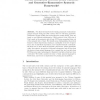Free Online Productivity Tools
i2Speak
i2Symbol
i2OCR
iTex2Img
iWeb2Print
iWeb2Shot
i2Type
iPdf2Split
iPdf2Merge
i2Bopomofo
i2Arabic
i2Style
i2Image
i2PDF
iLatex2Rtf
Sci2ools
LACL
2001
Springer
2001
Springer
On the Distinction between Model-Theoretic and Generative-Enumerative Syntactic Frameworks
Abstract. Two kinds of framework for stating grammars of natural languages emerged during the 20th century. Here we call them generativeenumerative syntax (GES) and model-theoretic syntax (MTS). They are based on very different mathematics. GES developed in the 1950s out of Post’s work on the syntactic side of logic. MTS arose somewhat later out of the semantic side of logic. We identify some distinguishing theoretical features of these frameworks, relating to cardinality of the set of expressions, size of individual expressions, and ‘transderivational constraints’. We then turn to three kinds of linguistic phenomena: partial grammaticality, the syntactic properties of expression fragments, and the fact that the lexicon of any natural language is in constant flux, and conclude that MTS has some major advantages for linguistic description that have been overlooked. We briefly consider the issue of what natural languages in MTS terms, and touch on implications for parsing and ac...
Automated Reasoning | Generativeenumerative Syntax | LACL 2001 | Model-theoretic Syntax | Natural Languages |
| Added | 30 Jul 2010 |
| Updated | 30 Jul 2010 |
| Type | Conference |
| Year | 2001 |
| Where | LACL |
| Authors | Geoffrey K. Pullum, Barbara C. Scholz |
Comments (0)

